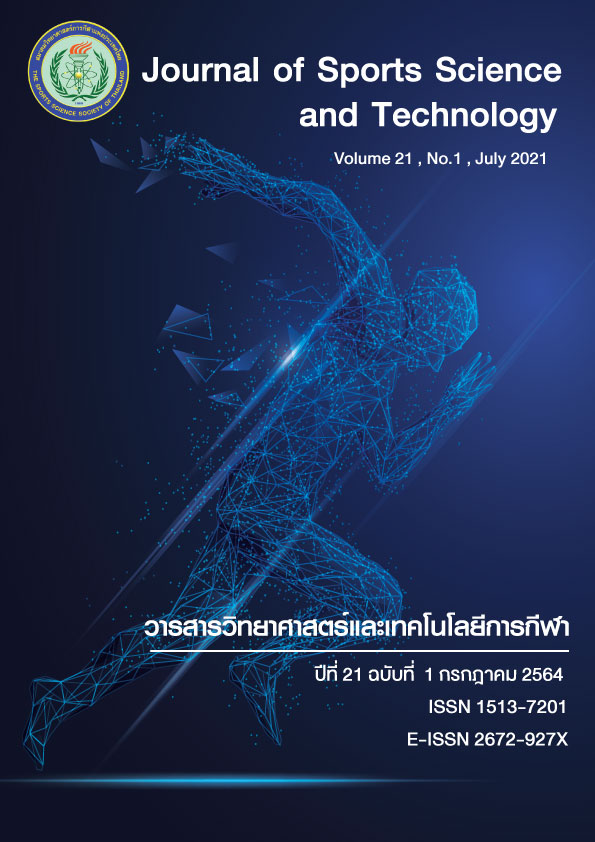SINGLE-LEG LANDING ERROR SCORING SYSTEM BETWEEN DOMINANT AND NON-DOMINANT LEG IN BASKETBALL PLAYERS
DOI:
https://doi.org/10.14456/jsst.2021.5Keywords:
Single-Leg Landing Error Scoring System/ Dominant and Non-Dominant Leg, Collegiate Basketball Players *CorrespondingAbstract
The purpose of this study was to investigate and compare SL-LESS between dominant leg and non-dominant leg. Fifteen male basketball players performed single-leg landing and were assessed by SL-LESS. The results showed that there was no significant difference of SL-LESS score between both dominant-leg and non-dominant leg. When compare each item including trunk knee and ankle, only knee valgus at initial contact was significant difference between the two conditions (p = 0.041). Additionally, there was decreased trunk flexion at initial contact, which would result in increased an injury risk. The result of this study may be useful for injury risk assessment in basketball players when landing. The data can be used for planning a training program to prevent injury.
(Journal of Sports Science and Technology 2021; 21(1):58-67)
(Received: 30 March 2021, Revised: 8 May 2021, Accepted: 18 May 2021)
Key words: Single-Leg Landing Error Scoring System/ Dominant and Non-Dominant Leg/ Collegiate Basketball Players
*Corresponding author: Parunchaya JAMKRAJANG College of Sports Science and Technology Mahidol University, Nakhon Pathom, Thailand 73170
E-mail: parunchaya.jam@mahidol.edu
References
2.Powell JW, Barber-Foss KD. Sex-related injury patterns among selected high school sports. The American journal of sports medicine. 2000;28(3):385-91.
3.Drakos MC, Domb B, Starkey C, Callahan L, Allen AA. Injury in the National Basketball Association: a 17-year overview. Sports health. 2010;2(4):284-90.
4.Padua DA, Marshall SW, Boling MC, Thigpen CA, Garrett Jr WE, Beutler AI. The Landing Error Scoring System (LESS) is a valid and reliable clinical assessment tool of jump-landing biomechanics: the JUMP-ACL study. The American journal of sports medicine. 2009;37(10):1996-2002.
5.Padua DA, DiStefano LJ, Beutler AI, De La Motte SJ, DiStefano MJ, Marshall SW. The landing error scoring system as a screening tool for an anterior cruciate ligament injury–prevention program in elite-youth soccer athletes. Journal of athletic training. 2015;50(6):589-95.
6.Beese ME, Joy E, Switzler CL, Hicks-Little CA. Landing error scoring system differences between Single-Sport and Multi-Sport female high School–Aged athletes. Journal of athletic training. 2015;50(8):806-11.
7.Chutisira N, Widjaja W, Pinthong M, Limroongreungrat W, Chaijenkij K. The landing error scoring system between recreational and collegiate female athletes. Journal of Sports Science and Technology. 2017:9-18.
8.James J, Ambegaonkar JP, Caswell SV, Onate J, Cortes N. Analyses of landing mechanics in division I athletes using the landing error scoring system. Sports health. 2016;8(2):182-6.
9.Bell DR, Smith MD, Pennuto AP, Stiffler MR, Olson ME. Jump-landing mechanics after anterior cruciate ligament reconstruction: a landing error scoring system study. Journal of athletic training. 2014;49(4):435-41.
10.Gokeler A, Eppinga P, Dijkstra P, Welling W, Padua D, Otten E, et al. Effect of fatigue on landing performance assessed with the landing error scoring system (less) in patients after ACL reconstruction. A pilot study. International journal of sports physical therapy. 2014;9(3):302.
11.O'Connor ML. The Development of the Single-Leg Landing Error Scoring System (SL-LESS) for Lower Extremity Movement Screening. 2015.
12.Pappas E, Hagins M, Sheikhzadeh A, Nordin M, Rose D. Biomechanical differences between unilateral and bilateral landings from a jump: gender differences. Clinical Journal of Sport Medicine. 2007;17(4):263-8.
13.Blackburn JT, Padua DA. Sagittal-plane trunk position, landing forces, and quadriceps electromyographic activity. Journal of athletic training. 2009;44(2):174-9.
14.Ford KR, Myer GD, Hewett TE. Valgus knee motion during landing in high school female and male basketball players. Medicine & Science in Sports & Exercise. 2003;35(10):1745-50.
15.Devita P, Skelly WA. Effect of landing stiffness on joint kinetics and energetics in the lower extremity. Med Sci Sports Exerc. 1992;24(1):108-15.






